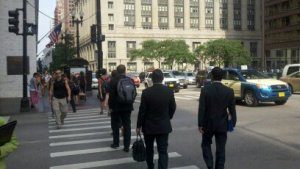Crosswalks aim to control traffic and protect pedestrians. While crosswalks increase pedestrian safety, cars hit many pedestrians crossing the street in marked and unmarked crosswalks.
Many negligent and reckless motorists blow through intersections without checking for pedestrians. When struck by motor vehicles, pedestrians can suffer severe and life-altering injuries. If a vehicle struck you or someone you love in a crosswalk, contact a Chicago pedestrian accident lawyer to discuss your case and determine your legal options.
At Abels & Annes, PC, we obtain successful results for victims of pedestrian accidents, including:
- $600,00 for severe injuries from a nighttime accident in a crosswalk
- $300,000 (policy limits) for a UM claim after a hit and run pedestrian accident
- $255,000 for a pedestrian who suffered head injuries
- $200,000 for injuries from a hit and run pedestrian accident
While each case will have a unique value, we always fight for the maximum available under the law.
The Different Types of Crosswalks
Crosswalks can provide pedestrians with a false sense of security. Pedestrians think that nothing threatens their safety when crossing in a crosswalk. Unfortunately, with so many negligent and reckless drivers on our roads, cars can strike pedestrians while in a crosswalk. Many crosswalk pedestrian accidents also occur due to improper road design or signs and faulty traffic lights.
Each year, thousands of pedestrians suffer injuries when crossing in a crosswalk.
These accidents occur at different types of crosswalks, which have different right-of-way rules:
- Crosswalks controlled by walk signals. In these crosswalks, pedestrians need to press the button and wait until the walk signal is active and traffic stops to cross the road.
- Crosswalks controlled by traffic lights. In these crosswalks, pedestrians must wait until the traffic signal tells them that it is safe to cross the road with a green light or walk sign.
- Marked crosswalks with no controls. In these crosswalks, pedestrians have the right of way. However, drivers need to see pedestrians waiting to cross to have enough time to come to a stop.
- Unmarked crosswalks with no controls. An unmarked crosswalk is located at an intersection and aims to serve as the imaginary extension of the sidewalk. These crosswalks have no painted lines or visible markings. Drivers are required to yield to pedestrians in unmarked crosswalks.
A pedestrian is jaywalking any time he or she crosses the road outside a marked or unmarked crosswalk. A pedestrian can receive a ticket for this illegal activity. Pedestrians are some of the most vulnerable road users who are at risk of severe injuries when a motor vehicle hits them.
The Right of Way in Crosswalk Pedestrian Accidents
Generally, pedestrians have the right of way in crosswalks, which means motorists must yield to pedestrians crossing the street. However, pedestrians who have not entered a crosswalk must yield to drivers until it is safe to enter the crosswalk and cross the road.
However, pedestrians do not have a right to run out into the middle of traffic at a crosswalk. Pedestrians must always make themselves visible and wait until it is safe to cross.
Because vehicles can cause life-threatening injuries to pedestrians, drivers must always exercise due care to avoid hitting pedestrians.
- Right of way in marked vs. unmarked crosswalks. Pedestrians have the right of way in marked and unmarked crosswalks. Unmarked crosswalks are typically located near the intersection and serve as the imaginary extension of the sidewalk. Marked crosswalks, on the other hand, have painted pints and other visible markings to alert drivers.
- Right of way in crosswalks controlled by traffic lights. At crosswalks controlled by traffic lights, motorists and pedestrians must obey signals. Pedestrians can enter the crosswalk only when they have the walk signal or green light. Motorists have the right of way when the light turns green.
When the pedestrian has the right of way at a marked or unmarked, controlled, or uncontrolled crosswalk, motorists must bring their vehicle to a complete stop rather than just slow down. Drivers must yield the right of way to pedestrians upon the driver’s half of the roadway or approaching so closely as to constitute a safety risk.
However, pedestrians cannot suddenly leave the curb or another place of safety and run into the path of a moving car. If a crosswalk pedestrian accident occurs after the pedestrian suddenly leaves the curb or runs into the vehicle, the opposing sides may dispute fault.
Common Causes of Crosswalk Pedestrian Accidents
There is a wide range of reasons vehicles hit pedestrians while in a crosswalk.
However, some of the most common causes pedestrians are struck by vehicles when crossing in a crosswalk include:
- Distracted driving. Driving while distracted is a dangerous behavior that puts pedestrians at risk. A driver may not notice a pedestrian crossing the street even when they take their eyes off the road for a few seconds. Common forms of distractions include texting while driving, adjusting the radio, talking to passengers, eating, daydreaming, and others.
- Driving under the influence of alcohol/drugs. Driving while impaired puts everyone, including pedestrians, at risk of harm. Drunk drivers have impaired judgment, slower reaction time, and poor coordination, all of which may prevent a driver from seeing a pedestrian in a crosswalk or stopping in time to avoid a collision. Pedestrians should always look both ways when crossing the street and watch out for impaired and distracted drivers.
- Impatient drivers. Many crosswalk pedestrian accidents occur because drivers are impatient. Many drivers think that traffic laws do not apply to them when they are in a hurry. They may disregard the safety of others and refuse to yield the right of way to pedestrians in a crosswalk because they do not want to lose a few seconds of their precious time.
- Reckless driving. Recklessness is a common cause of crosswalk pedestrian accidents. Any reckless driving behaviors, including speeding and running red lights, make drivers more likely to hit pedestrians.
- Bad weather conditions. Poor weather may contribute to crosswalk pedestrian accidents. For example, a driver may not stop in time to avoid hitting a pedestrian due to increased stopping distance in slippery road conditions.
Sometimes, an investigation by a lawyer may be necessary to determine what caused the accident and identify liable parties.
Crosswalks Are High Risk for Pedestrian Accidents
The greatest risks to pedestrians arise when pedestrians and automobiles use the same space. The best example of this is a crosswalk. A crosswalk is a marked or unmarked path designed for pedestrians to safely cross a street, road, or alley.
Crosswalks often are at intersections or corners of roads to make them convenient for pedestrian use. Further, they hopefully discourage walkers from crossing mid-block. Having a uniform location for crosswalks can also make it easier for drivers to anticipate the presence of pedestrians. Further, it should help them take appropriate steps to ensure pedestrian safety.
In a large city like Chicago, most crosswalks are clearly marked and identified. However, in smaller communities or less-traveled areas, crosswalks may be less noticeable. In Illinois, crosswalks can be either marked or unmarked. But, regardless of how they are designated, they are designed for pedestrian use.
Also, pedestrians generally have the right-of-way when using a crosswalk properly. This means following traffic signals for both vehicle and pedestrian traffic and staying within the confines of the crosswalk when walking across a street.
Common Injuries in Crosswalk Pedestrian Accidents
The type of accident typically determines a lot about the injuries. But whether a pedestrian was in a car accident, truck accident, or even bus accident, the pedestrian almost always suffers from injuries. They can range from mild to fatal.
The fact is that an automobile is a large, heavy, metal vehicle with many safety features to protect its occupants. In contrast, nothing protects a pedestrian from an impact.
This causes the pedestrian’s body to absorb much of the force of a crash, causing broken bones, scars, lacerations, or even death. Pedestrian accidents do not end for a victim once the crash is over. Rather, it can leave a victim suffering for months or even years.
Some of the most common types of injuries suffered by pedestrians in crosswalk accidents include:
- Traumatic brain injuries caused by the pedestrian hitting their head on the ground or vehicle.
- Internal injuries, including internal bleeding, caused by the trauma of the crash.
- Pelvic injuries as a result of blunt trauma suffered by the pedestrian.
- Spinal cord injuries, including paralysis.
- Broken bones caused by too much pressure exerted on the bones in pedestrian accidents.
Depending on the circumstances of the crosswalk pedestrian accident, a pedestrian may suffer injuries to the chest, abdomen, legs, and/or head. The type and severity of injuries in these accidents depend on the speed and type of the vehicle, among other factors.
Because of the nature of pedestrian accidents, pedestrians are 1.5 times more likely to suffer fatal injuries in traffic accidents than vehicle occupants, according to the Centers for Disease Control and Prevention.
Proving Driver Negligence in Crosswalk Pedestrian Accidents
Statistically speaking, car drivers are at fault in most pedestrian accidents. However, it is not uncommon for motorists and their insurance companies to argue that the pedestrian was partially or fully responsible for the accident. They may argue that the pedestrian was crossing the road against a red light or that the pedestrian ran into the vehicle's path.
Proving the driver’s negligence can become a complicated issue when the driver refuses to admit fault. In crosswalk pedestrian accidents when there is a dispute over fault, lawyers can prove negligence with the help of witness statements and surveillance video. Eyewitnesses can testify that the driver failed to slow down or stop when the pedestrian was crossing the road in a crosswalk.
Many buildings, stores, and light poles have cameras. If any camera captured the moment of the accident, the footage can prove the driver’s negligence. Consider contacting a Chicago crosswalk pedestrian accident lawyer to help you gather all available pieces of evidence to prove the driver’s fault.
Filing a Personal Injury Claim After a Crosswalk Pedestrian Accident
When filing a personal injury claim, the injured pedestrian has the burden to prove that the driver who hit them was negligent.
This requires the pedestrian and their lawyer to establish:
- Duty of care. The driver owed the pedestrian a duty of care. Depending on the circumstances of the crosswalk pedestrian accident, the duty may be to come to a complete stop and yield the right of way to the pedestrian.
- Breach of duty. The driver breached the duty of care by failing to yield the right of way to the pedestrian.
- Causation. The failure to yield the right of way was the direct cause of the accident and the pedestrian’s injury.
- Damages. The accident caused the pedestrian to suffer actual damages, including medical expenses, lost wages, disability, loss of enjoyment of life, and others.
A skilled lawyer can evaluate your pedestrian accident case to gather the necessary evidence to establish the above-mentioned elements of negligence. Consider consulting with a Chicago crosswalk pedestrian accident lawyer to discuss your particular case.
Seeking Compensation After a Crosswalk Pedestrian Accident

Injuries suffered by pedestrians when struck by motor vehicles can be devastating. Often, a pedestrian’s injuries are associated with mounting medical bills and an overwhelming loss of income. For this reason, pedestrians should explore their options for compensation to recover damages from the negligent driver.
Some of the most common types of damages injured pedestrians may recover following a crosswalk accident include:
- Medical expenses
- Loss of income
- Pain and suffering
- Diminished earning capacity
- Loss of enjoyment of life
- Reduced quality of life
- Disability
- Loss of consortium
If you or someone you love suffered injuries in a crosswalk pedestrian accident, seek legal counsel from a Chicago pedestrian accident attorney to evaluate your damages and losses and determine the available recovery options.
Abels & Annes, PC, can help you seek the compensation you deserve for your injuries, so please contact us as soon as possible at (312) 924-7575 for more information.

